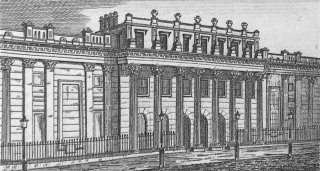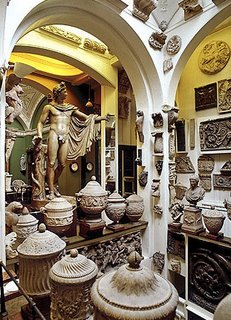Soane

The son of a bricklayer, born on this day in 1753 in Goring-on-Thames, England, John Soane studied architecture at the Royal Academy through the kindness of surveyor James Peacock and architect George Dance. In 1778 he went on the "Grand Tour" in Europe on a King's Travelling Studentship award, soaking in Roman classicism and meeting some influential British friends. He cut short his tour in 1780, however, and moved to Ireland, ostensibly to design and build a home for the Bishop of Derry, Lord Frederick Hervey; but unfortunately for the penniless Soane, nothing ever came of the project.
 Returning to England empty-handed, he married a wealthy heiress and slowly built a solid reputation as an honest and capable builder. After supervising the renovation of the home of William Pitt the Younger (a cousin of one of his Grand Tour buddies), Soane was named Surveyor of the Bank of England in 1788 and began to receive a number of prestigious commissions around London. Although some of his major works (the Law Courts, built in the 1820s; Freemasons' Hall in Great Queen Street, 1828; and the Bank of England, to which he devoted 45 years of his life) have been demolished or rebuilt on new designs, his exteriors have been highly admired by modern architects for their masculine simplicity, particularly where budgetary constraints forced him to pare them back to ordinary bricks with accents of Portland stone.
Returning to England empty-handed, he married a wealthy heiress and slowly built a solid reputation as an honest and capable builder. After supervising the renovation of the home of William Pitt the Younger (a cousin of one of his Grand Tour buddies), Soane was named Surveyor of the Bank of England in 1788 and began to receive a number of prestigious commissions around London. Although some of his major works (the Law Courts, built in the 1820s; Freemasons' Hall in Great Queen Street, 1828; and the Bank of England, to which he devoted 45 years of his life) have been demolished or rebuilt on new designs, his exteriors have been highly admired by modern architects for their masculine simplicity, particularly where budgetary constraints forced him to pare them back to ordinary bricks with accents of Portland stone.His own home in London at 12-14 Lincoln's Inn Fields exemplifies Soane's aesthetic interests from exterior to interior: plain and quiet on the outside, inside it is an intricate set of neoclassical catacombs, fastidiously outfitted with mirrors and colored glass skylights to create unusual top-lighting effects; and today it is filled with his vast, somewhat macabre collection of classical antiquities (some purchased from the estate of his former employer, architect Henry Holland) and other works of art (including Hogarth's original Rake's Progress painting series and a number of works by Canaletto), as well as with examples of his favorite decorative obsession, the architectural imagery of death -- urns, sarcophagi, and so on. Soane was so disappointed with his squandering sons that he obtained an act of Parliament before he died in 1837 which turned his prized home into a public treasure, now known as the Sir John Soane Museum.
Labels: Architecture





1 Comments:
I have visited this charming gallery when I was in London. I was impressed by it and I spent a lot of time admiring Hogarth's and Canaletto's canvas.
Post a Comment
Subscribe to Post Comments [Atom]
<< Home